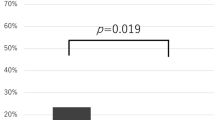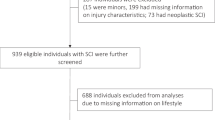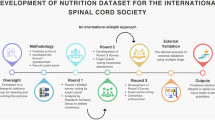Abstract
Objectives:
The present study was undertaken to review the service provision in spinal cord injury (SCI) centres (SCICs); to establish and compare how much time dietitians spend in direct and indirect contact with patients; and to document current nutritional screening practices.
Methods:
All 12 SCICs in the United Kingdom and the Republic of Ireland were surveyed by a postal questionnaire in April 2014. Data collected included the number of whole-time-equivalent (WTE) staff available, whether a nutrition team was present and the use of nutrition screening tools. A work sampling tool was used to capture dietetic activity for a period of 1 week.
Results:
Eight (66.7%) SCICs responded (390/531 of total SCI beds) and the average numbers of patients per WTE staff, including consultants, nurses, dietitians, physiotherapists, occupational therapists were recorded. Six out of eight SCICs used a validated nutritional screening tool. Thirty-two work sampling tools were analysed, revealing that spinal dietitians spend 39.1% of the working day in direct patient-related activities. Staffing levels varied and were below clinical recommendations in six out of eight SCICs.
Conclusion:
The resources allocated to nutritional care in SCICs appear to be varied and limited. This suggests malnutrition may continue to be under-recognised and under-treated. To address the complex nutritional needs of this special population group there is a clear need to establish staffing level for dietitians. Information collected from the present study could contribute to the supply analysis of a future workforce planning exercise in SCIC dietetic service.
Similar content being viewed by others
Log in or create a free account to read this content
Gain free access to this article, as well as selected content from this journal and more on nature.com
or
Change history
04 December 2015
This article has been corrected since advance online publication and a corrigendum is also printed in this issue.
References
O’Riordan J Workforce Planning in the Irish Public Service. Research Paper no. 7. Institute of Public Administration: Dublin, Ireland http://www.ipa.ie/pdf/WorkforcePlanning_2011.pdf (accessed 08 February 2015), 2011.
NHS England NHS Allocations for 2013/14 http://www.england.nhs.uk/allocations-2013-14/ (accessed 15 December 2014), 2013.
Meyer MK, Oslen MS . Productivity of the clinical dietitian; measurement by refression model. J Am Diet Assoc 1989; 89: 490–493.
Schoo AM, Boyce RA, Ridoutt L, Santos T . Workload capacity measures for estimating allied health staffing requirements. Aust Health Rev 2008; 32: 548–558.
Cartmill L, Comans TA, Clark MJ, Ash S, Sheppard L . Using staff ratios for workforce planning: evidence on nine allied health professions. Hum Resour Health 2012; 10: 2.
Wong S, Derry F, Grimble G, Forbes A . How do spinal cord injury centres manage malnutrition? A cross-sectional survey of 12 SCIC in the UK and Ireland. Spinal Cord 2011; 50: 132–135.
Ward F, O’Riordan J. A review of staffing levels and activity in paediatric dietetics. J Hum Nutr Diet 2014; 28: 95–106.
Scottish Executive Allied Health Professions: Workload Measurement and Management http://www.sehd.scot.nhs.uk/ahp/_documents/AHP (accessed 20 July 2014), 2006.
Windle EM . Adequacy of dietetic service provision to adult critical care: a survey of 33 centres in Northern England. J Hum Nutr Diet 2007; 20: 111–120.
Windle EM . Nutrition support in major burn injury: case analysis of dietetic activity, resources and cost implications. J Hum Nutr Diet 2008; 21: 165–173.
New PW, Scivoletto G, Smith E, Townson A, Gupta A, Reeves RK et al. International survey of perceived barriers to admission and discharge from spinal cord injury rehabilitation units. Spinal Cord 2013; 51: 893–897.
Joint Standard Development Groups of the South England Review Group Standard for patients requiring spinal cord injury care (Revised 2010) http://www.secscg.nhs.uk/EasySiteWeb/getresource.axd?AssetID=99975&type=full&servicetype=Attachment (assessed 20 November 2010) 2010.
NHS England NHS standard contract for spinal cord injuries (all ages). NHS England, Redditch http://www.england.nhs.uk/wp-content/uploads/2013/06/d13-spinal-cord.pdf (accessed 09 September 2013), 2013.
Health Research Authority Defining Research, NRES guidance to help you decide if your project requires review by a Research Ethics Committee http://www.hra.nhs.uk/documents/2013/09/defining-research.pdf (accessed 15 December 2014), 2013.
Elia M (ed) Screening for Malnutrition: A Multidisciplinary Responsibility. Development and use of the ‘Malnutrition Universal Screening Tool’ (‘MUST’) for Adults. British Association of Parenteral and Enteral Nutrition, Redditch, UK, 2003.
Wong S, Derry F, Jamous A, Hirani SP, Grimble G, Forbes A . Validation of the Spinal Nutrition Screening Tool (SNST) in patients with spinal cord injuries (SCI) – result from a multicentre study. Eur J Clin Nutr 2012; 66: 382–387.
Wong S, Derry F, Jamous A, Hirani SP, Forbes A . Is undernutrition risk associated with an adverse clinical outcome in spinal cord-injured patients admitted to a spinal centre? Eur J Clin Nutr 2014; 68: 125–130.
Hendrich A, Chow MP, Skierczynski BA, Zhenqiang L . A 36-hospital time and motion study: How do medical-surgical nurses spend their time? Perm J 2008; 12: 25–34.
Weigl M, Muller A, Zupanc A, Angerer P . Participant observation of time allocation, direct patient contact and simultaneous activities in hospital physicians. BMC Health Serv Res 2009; 9: 1–11.
National Institute for Health and Clinical Excellence (NICE) Nutrition Support in Adults: Oral Nutrition Support, Enteral Tube Feedings and Parenteral Nutrition. NICE, London 2006.
Council of Europe Committee of Ministers Resolution RESAP on food and nutritional care in hospitals https://wcd.coe.int/ViewDoc.jsp?id=857472003.
Roethlisberger FJ, Dickson WJ . Management of the Worker. Harvard University Press: Cambridge, MA, USA. 1939.
Finckler S, Kinckman JR, Hendrickson G, Lipkin M Jr, Thompson WG . A comparison of work sampling and time and motion techniques for studies in health service research. Health Serv Res 1993; 28: 577–597.
The British Dietetic Association Caseload Management. Birmingham: The British Dietetic Association: Birmingham, UK. 2012.
Acknowledgements
We are grateful to all medical staff facilitating the dissemination of study questionnaires from the UK and the Republic of Ireland. We thank Alice Defriez for reviewing the manuscript. We also thank the following persons who provided information for this study: Anthony Twist, Sian Gruffudd, Lucy Hewitson, Lorna Fitzsimons, Laura Keaskin, Philippa Bearne, Dot Tussler and Alan McLean and Liz Cole.
Author Contributions
SW was involved in protocol and questionnaire development, data analysis and manuscript preparation; AG was involved in data collection and manuscript revision; SPH was involved in questionnaire development, data analysis and manuscript revision; DC was involved in data collection and manuscript revision; SC was involved in data collection and manuscript revision; EM was involved in data analysis and manuscript revision; CT was involved in data collection and manuscript revision; MS was involved in questionnaire development, data analysis and manuscript revision. All authors contributed to the preparation of the report.
Author information
Authors and Affiliations
Corresponding author
Ethics declarations
Competing interests
Parts of the study data were presented at the International Spinal Cord Society Meeting in May 2015, in Montréal, Québec, Canada.
Additional information
Supplementary Information accompanies this paper on the Spinal Cord website
Supplementary information
Rights and permissions
About this article
Cite this article
Wong, S., Graham, A., Hirani, S. et al. Review of dietetic service provision and activity in spinal cord injury centres: a multicentre survey in the UK and Republic of Ireland. Spinal Cord 53, 855–859 (2015). https://doi.org/10.1038/sc.2015.83
Received:
Revised:
Accepted:
Published:
Issue date:
DOI: https://doi.org/10.1038/sc.2015.83
This article is cited by
-
Recent Updates in Nutrition After Spinal Cord Injury: 2015 Through 2021
Current Physical Medicine and Rehabilitation Reports (2022)
-
Detecting malnutrition risk and obesity after spinal cord injury: a quality improvement project and systematic review
European Journal of Clinical Nutrition (2018)



